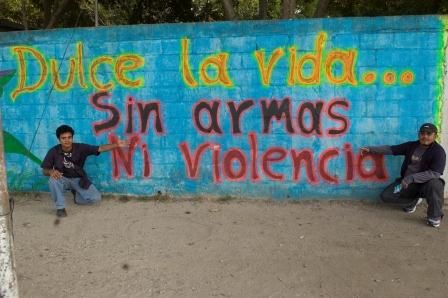Replicating the Salvadoran gang truce?

In March 2012, the heads of the two largest gangs operating in El Salvador, Mara Salvatrucha (MS-13) and Barrio 18, established a truce, agreeing to end hostilities and pledging to reduce the number of homicides. In October, Ana Glenda Tager Rosado, Interpeace Regional Director for Central America, participated in a forum on ‘Improving Security in Central America: Regional Options for Responding to Youth Violence’ in Washington D.C. Ana Glenda assessed the outcomes of this truce and talked about the bigger picture of youth violence prevention in Central America.
The importance of a preventive approach
The agreement between the MS-13 and Barrio 18 gangs came about at a time when the homicides rates were on an alarming increase in El Salvador. However, as Ana Glenda pointed out, the actual responsibility of gangs in this surge of violence varies a great deal depending on the sources. The general opinion though, among the public, the media and the authorities, clearly blames the gangs. As a result, the government long favored a repressive, zero-tolerance approach towards gang members – with little success.
In recent years, as a result of pressure from civil society organizations and the international community, the concept of prevention has gradually been introduced as a strategy in the official discourse and is slowly starting to be implemented in projects and programmes. The gang truce will only be sustainable if preventive measures will be included as well.
An interesting experiment
So far though, the truce seems to be having an encouraging impact in El Salvador, with a dramatic decline in the homicide rate by nearly 60%. These results seem to corroborate the presumption that gangs have a major responsibility for the high violence rates. It would therefore be tempting to try to replicate the Salvadoran truce in other countries in the region. But before jumping to conclusions, Ana Glenda underlined the need to assess the situation more carefully.
“In light of the optimism generated by the decline in murders, the truce is still an experiment with an uncertain future,” explained Ana Glenda. “If the truce is interrupted, it could generate even more violence than before. It is even more important to make this a self- sustaining initiative by considering the truce as one step towards a more peaceful society. But further steps are needed as well, like working with victims, providing opportunities for youth at risk, or improving the living conditions in prisons. Moreover, despite the similarities El Salvador shares with its neighboring countries, it is necessary to distinguish the particularities of each context, notably the gang dynamics. For Ana Glenda, truces to reduce homicide rates are only a starting point for a much broader and more inclusive process that aims to identify and eradicate the causes of violence.
Making the process sustainable
“For Interpeace, it is important to emphasize that, regardless of the political contexts and the common denominators between countries, the possibility to replicate the Salvadoran experiment will depend largely on the Salvadoran society’s ability to generate a comprehensive and sustainable process that transcends the truce,” explained Ana Glenda.
This involves envisioning the problem of violence holistically and not just from a criminological point of view. In that sense, the truce can be seen as an important component of the process, but other steps are also necessary to achieve a sustainable reduction of violence. The gang phenomenon in Central America does not work according to the same logic as organized crime. The ultimate goal of criminal organizations is profit. Gangs on the other hand, although they sometimes also seek profit, offer the young people who swell their ranks a kind of family, an identity, a place in the world. They reflect a phenomenon of social, economic and political exclusion that results in racism, poverty and inequality.
Therefore, essential components of the process to curb violence are also:
- Social reinsertion, or the creation for Salvadoran youth of viable alternatives to gang life, of opportunities to integrate society and live decently;
- Educational and recreational opportunities for young people who are at risk of joining gangs;
- Rehabilitation mechanisms for detainees, starting with better living conditions and compliance with human rights in detention centers; and
- Comprehensive support for victims of gangs, helping them become agents of change.
The full text of Ana Glenda Tager Rosado’s presentation is available in Spanish.
